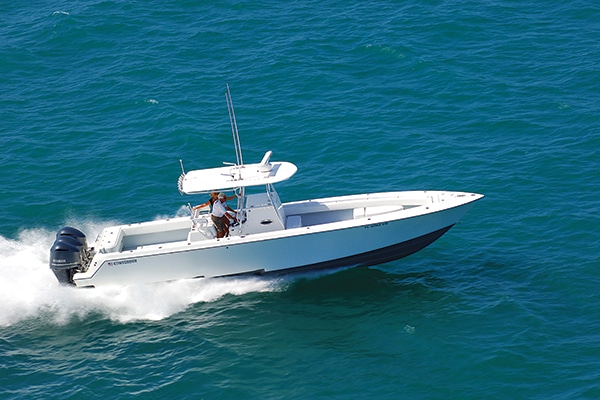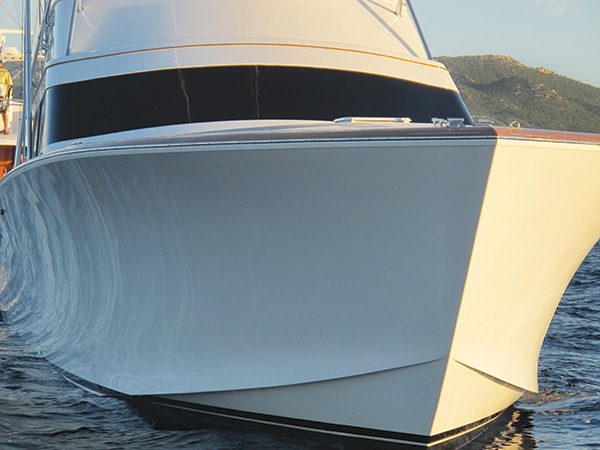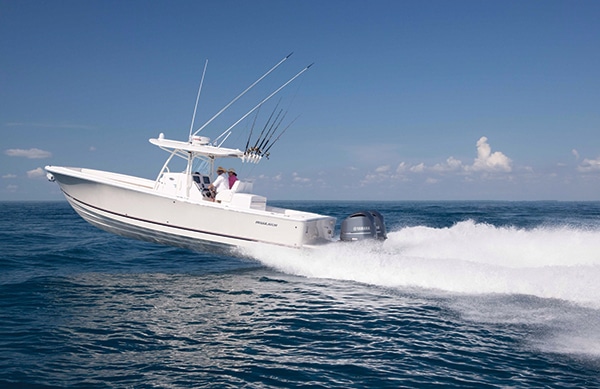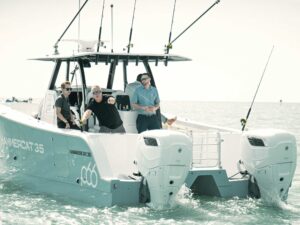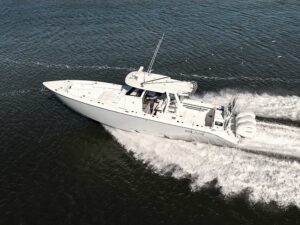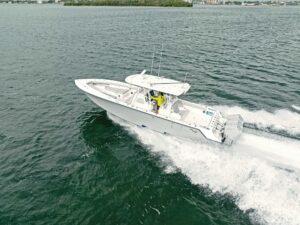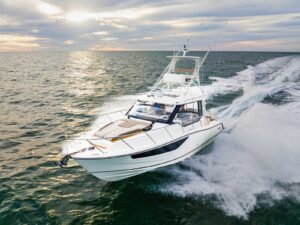To efficiently complete a task, a craftsman needs the right tools for the job. The same principle applies to boat hulls. Like tools, a hull is designed for specific purposes or boating conditions. Pick the wrong one and disappointment awaits. But a hull that is designed for your normal operating environment makes the trip more enjoyable, and usually means more fish. I asked a couple of marine-industry veterans their thoughts on the most important characteristics in designing outboard-powered hulls.
Balance
“The center of gravity is 100 percent vital in everything we do,” says Lou Codega, a naval architect with more than 35 years of experience in boat design. Codega has developed every Regulator hull, and also has worked with Carolina Classic, Cabo and Hines-Farley, along with trawler and work-boat companies. “The difference between a lousy boat and a great boat is how well its designer and the builder work together to get the total weight of the boat balanced. If it’s off, bad things happen. Too far aft, and the boat porpoises. Too far forward, and the boat plows in a head sea. So the center of gravity and balanced weight are critical design and construction elements,” he says.
Codega’s Regulator designs feature a modified V-hull with a sharp bow entry approaching 50 degrees that transitions aft to 24 degrees deadrise (the angle at the stern). These characteristics give the best combination of seakeeping, handling and weight-to-horsepower ratio, he feels. He uses hard outside chines for these planing hulls, and has specific power packages in mind before he sits down at the computer. He’s also a big fan of engine brackets.
Matched Power
“These days we design the boats mainly for specific power packages, with some allowable variances. For example, a boat built for twin 200s can also typically handle a single F350. The lighter, more-powerful four-stroke outboards have definitely made my job easier,” says Codega. “I also design a lot of boats with engine brackets. The first one I did was the Regulator 26. Brackets increase engine efficiency by moving the props away from hull turbulence, lengthen the running surface, and increase the usable cockpit space. I think brackets work well in a lot of applications.”
Codega says another effective hull design is the variable deadrise version, first made popular by Seacraft and later Sailfish Boats. This design divides the hull in transverse sections, with the sharpest deadrise along the keel in order to minimize pounding in bigger seas. The outward radiating angles of the chines decrease proportionally to add stability and lift.
“I’m not sure this design is any better than a good modified-V hull, but a lot of people swear by them. I’ve run a couple of Seacraft, and they’re good seaworthy boats,” Codega says.
Offshore Tough
South Florida-based Contender Boats has a 30-year track record of building outboard-powered hulls for challenging offshore conditions. The company offers 21 models ranging from 21 to
40 feet, and except for its 25 Bay and
40 Express, all feature a transom deadrise of 24.5 degrees. Contender’s Les Stewart Jr. explains why.
“When you’re running hard offshore, you need enough of an entry to cushion the boat in head seas yet be stable at rest. We started using this formula a long time ago, and it’s a perfect number for us. It gives us our famous ride,” he says. “We use reverse-radius chines to force the water along the hull and back down to keep the boat dry. We also took quite a bit of time designing our chine lines to keep the boat quiet. We didn’t want to scare the fish.”
Recently Contender hired John Cosker of Mystic Powerboats to design their stepped hulls. Cosker — best known on the offshore powerboat-racing circuit with the Miss Budweiser and Miss Geico hulls to his credit — came up with the twin-stepped, ventilated deep-V design that is offered on the Contender’s four ST models: 30, 32, 35 and 39.
Stepped-Up Economy
“The traditional stepped-hull design starts with a deep-V at the bow that transitions to a pad astern,” Stewart explains. “That helps increase speed, but you lose a lot of the ride, and it’s known to pound. With our twin steps, we’ve ventilated the hull and kept our hard keel line. It’s solid in the water and holds a heading without slippage. And the ride is very soft in a head or following sea. Our stepped hulls have 18 percent better fuel efficiency and
10 percent better performance than our traditional hulls.”
Stewart says that with today’s fuel prices and more-efficient four-stroke power, the stepped-hull option makes a lot of sense for many buyers. Power requirements are comparable between conventional and stepped hulls.
“Our customers are looking to go faster and farther while spending less,” he adds. The power-to-weight ratios are also similar, so the number of outboards and the horsepower choice comes down to a matter of preference.
“On our 35ST, for example, you can rig it with triple 300s for a 72 to 74 mph package, or go with twin 300s and do 60 mph, and get incredible fuel economy. With triples, the engines don’t have to work as hard to push the boat, so it just depends on what you want it to do.”
Stewart doesn’t see any difference between the two styles in terms of slow-trolling, but the stepped hulls do produce a more pronounced wake at higher speeds. However, there’s no evidence that stepped hulls will raise any more fish. Fish-raising ability depends more on angler skill than hull design, Stewart believes.
Before settling on a particular hull design, both Codega and Stewart urge prospective buyers to determine how and where they’ll use the boat long before heading to the showroom. Once you get there, get down and look at the actual hull surface, and ask a lot of questions to make sure it’s the right one for you. Buyer’s remorse is never good when it comes to a purchase as important as your boat
